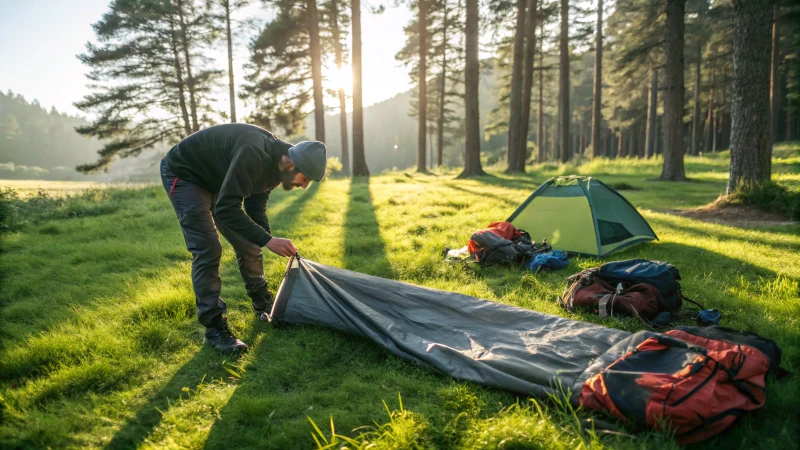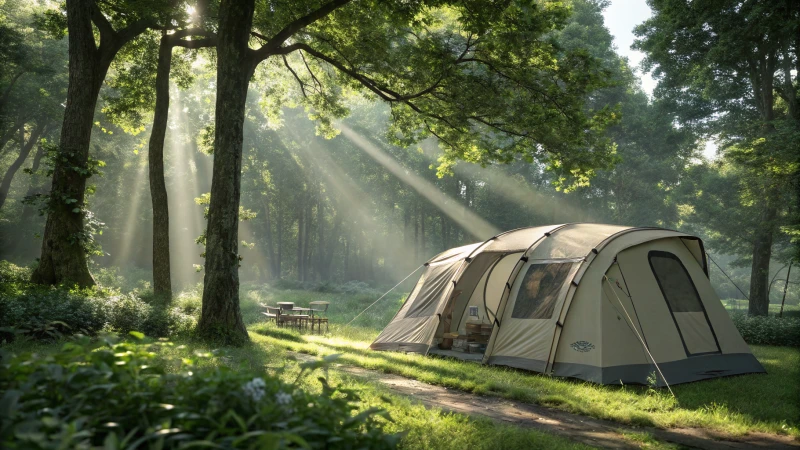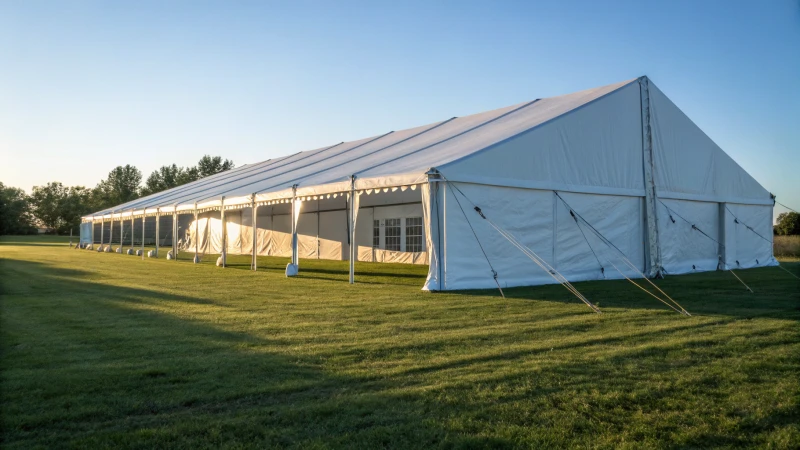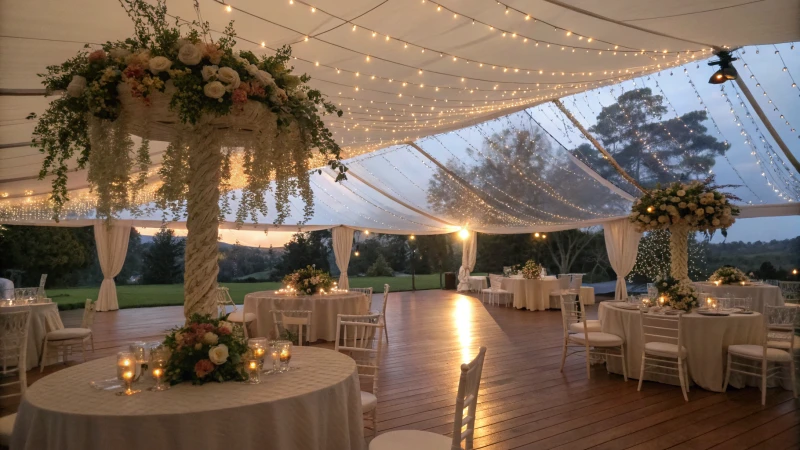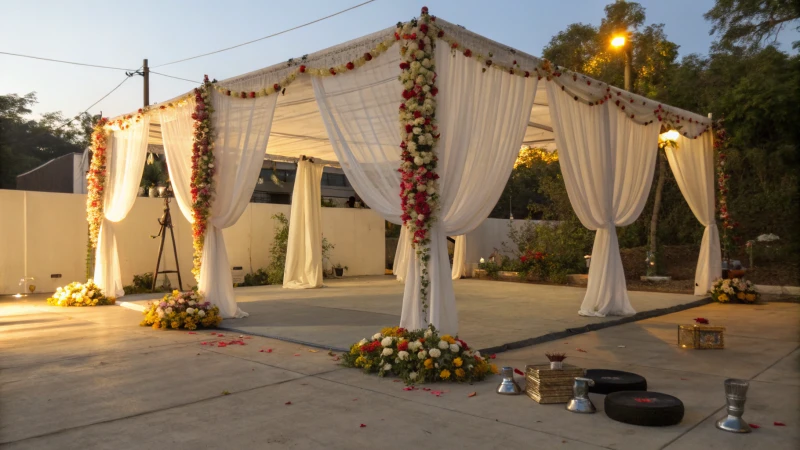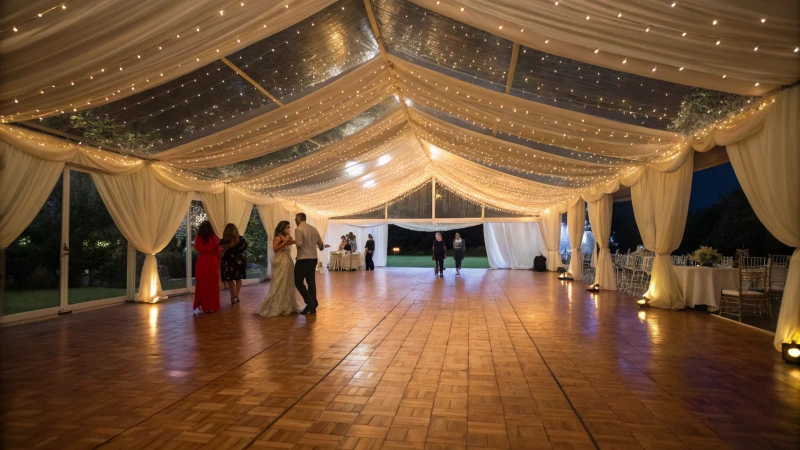
Ever tried dancing in a party tent? It’s an experience like no other! With the right setup, your guests will be grooving all night long.
To set up a dance floor in a party tent, choose a central, level spot, use modular dance floor panels, and enhance with mood lighting. Safety first!
I remember my first attempt at setting up a dance floor in a tent for a friend’s wedding. The excitement was palpable, but I quickly realized the ground wasn’t as level as it seemed. A few adjustments later, using some sturdy plywood to even things out, and we were back on track. The magic really happens when you start laying down those modular panels—they click into place like pieces of a puzzle, transforming the space instantly. Add a few strings of fairy lights or maybe even a disco ball, and you’ve got a dance floor that rivals any club. Trust me, seeing your guests light up when the music starts is worth every bit of effort.
A dance floor requires modular panels for setup.True
Modular panels are essential for creating a stable and adaptable dance floor.
Lighting is unnecessary for a tent dance floor.False
Lighting enhances ambiance and visibility, making it crucial for a tent setup.
What Are the Best Materials for a Tent Dance Floor?
Imagine your guests twirling under the stars, their feet gliding smoothly on the perfect dance floor you’ve set up inside your tent.
The best materials for a tent dance floor are wood, vinyl, and LED panels. Wood exudes timeless elegance, vinyl offers easy maintenance, and LED panels bring dynamic lighting to the party. Each material has its own benefits and challenges, impacting cost, durability, and installation ease.

I still remember the first time I set up a dance floor for an event. It was my niece’s wedding, and I wanted everything to be perfect. We chose wood for its classic charm, imagining how beautiful it would look under the soft glow of fairy lights.
Wood Dance Floors
Wood has a natural beauty that’s hard to resist, making it ideal for weddings or any formal occasion. The rich texture and polished finish create a sophisticated ambiance that invites everyone to dance.
Pros:
- Exudes classic elegance with a polished look.
- Built to last through many events.
Cons:
- Installation and upkeep can add up.
- Needs a solid, even foundation beneath.
Explore more about wood dance floor options1.
Vinyl Dance Floors
During another event, we opted for vinyl due to its affordability. I was amazed at how easily it could mimic more expensive materials while still being easy to clean after a long night of dancing.
Pros:
- Simple to maintain and clean.
- More budget-friendly than wood.
Cons:
- Might not provide the upscale feel of wood.
- Prone to faster wear with heavy use.
Learn how to select the best vinyl flooring for events2.
LED Dance Floors
Then there was the anniversary party where we went all out with an LED floor. Watching the lights sync with the music was magical, creating an unforgettable experience.
Pros:
- Offers mesmerizing visual effects.
- Customizable lighting patterns.
Cons:
- Higher initial investment.
- Careful handling needed during setup and removal.
Discover why LED dance floors are trending3.
Comparison Table \
n| Material | Aesthetic Appeal | Cost | Ease of Installation | Maintenance |
n|———-|——————|——|———————-|————-|
n| Wood | High | $$$$ | Moderate | Moderate |
n| Vinyl | Moderate | $$ | Easy | Easy |
n| LED | High | $$$$ | Complex | Moderate |
nChoosing the right material for your tent dance floor involves balancing your event’s theme, budget, and logistical needs. Weighing these pros and cons will help ensure your guests have an enchanting experience they’ll cherish forever. \
nExplore further about tent dance floor setups4.
Wood dance floors require a flat, solid surface.True
Wood floors need stability for proper installation and durability.
LED dance floors are the most affordable option.False
LED floors are more expensive due to technology and setup costs.
How Can You Ensure Safety on a Tent Dance Floor?
Planning a dance floor in a tent for your next big event? It’s crucial to prioritize safety while keeping the fun alive.
To ensure safety on a tent dance floor, choose slip-resistant materials, level the ground, secure edges, and regularly check stability. Good lighting and clear signage further enhance safety.

Choosing the Right Dance Floor Material
I remember the first time I had to set up a dance floor in a tent; I was both excited and anxious. Would it hold up? Would people enjoy it without worrying about slipping? After some research, I opted for modular dance floors5 that were not only portable but came with non-slip finishes. These made dancing fun and safe, keeping everyone on their feet—literally.
Preparing the Ground
Leveling the Surface:
The ground preparation was a challenge. We had this beautiful grassy area, which was great for aesthetics but not so much for stability. I learned that ensuring a flat surface was essential. So, armed with a shovel and rake, I worked on leveling the area. For the softer spots, laying down a plywood subfloor provided that much-needed firmness.
| Task | Tools Required |
|---|---|
| Leveling ground | Shovel, Rake |
| Laying subfloor | Plywood, Nails |
Assembling and Securing the Dance Floor
Interlocking Panels:
Following the manufacturer’s guidelines was crucial when connecting panels. They needed to stay put even under the enthusiasm of the crowd. Edge ramps were a must—they smoothed out transitions and minimized tripping hazards. Before guests arrived, I made sure to walk around and test the stability myself.
Regular Inspection:
This step can’t be overstated. Checking everything before the event ensured peace of mind and allowed me to focus on enjoying the occasion.
Enhancing Visibility and Safety
Lighting transforms a space, doesn’t it? I found string lights or spotlights not only added to the ambiance but also enhanced safety by improving visibility. Strategic placement of safety signs helped guide guests away from potential hazards. Having emergency lighting options6 ready was an added layer of security.
Training and Awareness
Involving my team in basic safety measures was another step I took. We ran through a couple of drills, which helped everyone feel prepared for any unexpected situations. It’s always reassuring to know that help is just an arm’s length away.
Additional Resources
Consulting with event safety professionals turned out to be a valuable decision for tailoring advice specific to my setup. Plus, joining event safety forums7 provided insights from others who’d been there, done that, and had some creative solutions to share.
Focusing on these elements allowed me to create a space where everyone could let loose and have fun, knowing they were safe. And isn’t that what truly makes an event memorable?
Modular dance floors are non-slip and easy to assemble.True
Modular floors have non-slip finishes and are portable, ensuring safety.
Plywood subfloors are unnecessary on soft surfaces like grass.False
Plywood provides stability on uneven or soft surfaces, preventing falls.
How Do You Determine the Right Size for Your Tent Dance Floor?
I remember my first big event where I had to figure out the dance floor size under a tent. It was like solving a puzzle—getting it just right so everyone could boogie without bumping into each other! Let’s dive into how you can crack this code too.
The perfect tent dance floor size hinges on how many guests will hit the dance floor. Aiming for about 4.5 square feet per dancer should do the trick. So, if you’re expecting 50 dancers, you’ll want a dance floor around 225 square feet.

Calculating Dance Floor Size
When I first started planning events, one golden rule stuck with me: every dancer needs space to let loose! So, I usually allocate about 4.5 square feet per person. This simple calculation has never let me down and keeps everyone twirling happily.
Here’s a handy reference table I’ve leaned on countless times:
| Number of Dancers | Dance Floor Size (sq ft) |
|---|---|
| 25 | 113 |
| 50 | 225 |
| 75 | 338 |
| 100 | 450 |
Of course, depending on your event—say, a wedding with lots of slow dances or a vibrant salsa night—you might need to tweak these numbers. Consider adjusting these figures based on event type8 and dance style9.
Considerations for Placement
I’ve learned that placing the dance floor near the DJ or band not only looks great but also draws people in like magic. It becomes the heart of the party, and who doesn’t want to be in the middle of all that fun?
For more detailed insights on this, take a look at these placement strategies10.
Flooring Material and Safety
Safety first—always! I can’t stress enough the importance of choosing the right material. Portable dance floors are my go-to; they’re easy to set up and have beautiful finishes. Just make sure they’re non-slip—nothing kills a dance vibe like a slip and slide that’s not on purpose!
For more options, check out dance floor materials11. Trust me, getting the material right makes all the difference in creating a safe and joyous atmosphere.
Each dancer needs 4.5 sq ft on the dance floor.True
Allocating 4.5 square feet per person allows enough space to dance.
A 100-person dance floor should be 500 sq ft.False
The correct size for 100 dancers is 450 square feet, not 500.
How Can Lighting Enhance Your Tent Dance Floor?
Remember that magical evening when the lights danced as much as we did? Let’s recreate that unforgettable atmosphere with the perfect lighting for your tent dance floor.
Lighting enhances a tent dance floor by setting the mood and creating an immersive experience. Using spotlights, string lights, or LED panels can transform the space into an enchanting dance haven.

Creating Ambiance with String Lights
I remember one of my first events where I used string lights. The soft, warm glow wrapped around the tent like a comforting hug, instantly transforming it into a magical canopy12. I draped them across the ceiling, creating a twinkling canopy that mesmerized everyone. The way they hung at different heights added a dynamic visual element that guests couldn’t stop admiring.
Tips for Installation
- Height: Hang lights at varying heights for a dynamic look.
- Patterns: Use zigzag or spiral patterns to enhance visual appeal.
- Color: Opt for white lights for elegance or colored lights for vibrancy.
Setting the Mood with Spotlights
There was this time I used spotlights at a friend’s wedding to highlight the couple during their first dance. It was magical how the light seemed to embrace them as they moved, adding drama and excitement. Spotlights can focus attention beautifully on specific areas like the dance floor center or a featured performer, making moments unforgettable.
Spotlight Features
| Feature | Benefit |
|---|---|
| Adjustable Beam | Focus light where needed |
| Color Filters | Create varied moods and themes |
| Dimming Controls | Adjust brightness throughout event |
Utilizing LED Panels for Dynamic Effects
LED panels remind me of those vibrant nights when the music’s beat seemed to sync with the lights perfectly. They offer a modern twist with patterns and colors that change dynamically, ideal for high-energy events. Their versatility in pattern customization and color variety lets you fit any theme or mood effortlessly.
- Pattern Customization: Sync with music for rhythmic effects.
- Color Variety: Choose from a spectrum of colors to match your event’s theme.
- Portability: Easy to set up and dismantle, perfect for temporary setups.
Enhancing with Laser Lights
Once, I added laser lights to a tent setup, aiming to create a futuristic vibe. Watching guests’ faces light up as they moved through the patterns was priceless. These lasers created moving designs that captivated everyone, though I learned to use them sparingly to avoid overwhelming anyone.
Explore laser options13 suitable for different event types.
By exploring these lighting options, you can craft a tent dance floor that not only looks stunning but also draws guests in, encouraging them to dance and enjoy the celebration. Let’s create those unforgettable memories together.
String lights can create a cozy ambiance on a tent dance floor.True
String lights provide a soft, warm glow, enhancing coziness.
Laser lights should be used abundantly for best effect.False
Lasers should be used sparingly to avoid overwhelming the senses.
Conclusion
Setting up a dance floor in a party tent involves choosing a level area, using modular panels, ensuring safety, and enhancing ambiance with lighting for an unforgettable experience.
-
Find out more about various wood types available for dance floors to choose one that fits your event’s aesthetic. ↩
-
Discover how vinyl flooring can offer versatility and cost-effectiveness for event setups. ↩
-
Understand the advantages of using LED dance floors, including customization options and visual impact. ↩
-
Learn detailed steps for effectively setting up a dance floor in a tent environment. ↩
-
Explore popular options for portable dance floors to ensure durability and safety. ↩
-
Discover essential lighting solutions that enhance visibility and safety at events. ↩
-
Join discussions on event safety to learn from experts and improve your setup. ↩
-
Different events have varying space needs due to formality and dance styles. ↩
-
Understanding dance styles helps tailor the dance floor size to specific movements. ↩
-
Proper arrangement enhances event flow and maximizes guest engagement. ↩
-
Selecting the right material ensures safety and complements event aesthetics. ↩
-
Discover top-rated string lights that enhance outdoor event ambiance with ease. ↩
-
Find creative laser light patterns that elevate party atmospheres effortlessly. ↩



